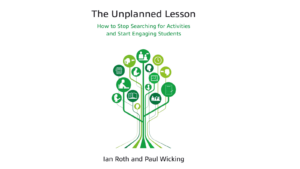1001 Discussion Questions to Use with Your EFL / ESL Students
By James M. Taylor (Author), Taylor Made English
A Book Review by Vicky Loras, Language Teacher
That conversation group you have every Tuesday – you have exhausted every single topic with them, be it current ones or topics of the past; you have used all kinds of pictures to describe with them and in general, feel stuck on the same questions with them. Those last ten minutes when your private student does not want to do the Present Perfect vs. the Past Simple anymore, and you are looking to fill with something new, for the lesson to end on a high note.
What do we do when there is a slump in the middle of a lesson on a hot summer afternoon and nobody is in the mood to do listening comprehension?
What can we do in those minutes, in that hour or more?
James M. Taylor, a language teacher based in Brazil, with many years of experience in teaching, podcasting and presenting,has taken care of that, to a great extent, with his new book How Was Your Weekend? 1001 Discussion Questions to Use with Your EFL / ESL Students.
The author mentions in the introduction that the idea to write this book came out of a similar situation he encountered with his students where he found himself asking them the same questions all the time. And how fortunate we are as language teachers, many of us in the same predicament, to have this book in our classrooms!
This book is truly a gift to us as teachers, and to our students.
First of all, the number of questions is one of the greatest things about this book. Just imagine,1001 questions to ask our students and hold amazing and constructive discussions with them. We may not use all these questions with all our students, and perhaps in some cases not even all the categories, as we will deem which ones are to be used with our students in our specific teaching contexts; even so, the number of discussion questions is enormous.
The author includes some very useful guidelines on how to use the questions at the beginning of the book.
The Things to consider part in the first pages of the book has more details on how to use the book depending on cultural or personal sensitivity and what sort of relationship you have with your students and more – a very thoughtfully-written part of the book.
Another very positive and helpful aspect of the book is that the questions are divided into twenty-eight categories, some of which are: You, Life, Travel, People, Fashion, Money and Possessions, History, Beliefs.
With one conversation group I teach, this book came as a huge gift, as I have had them for a very long time and I felt I needed something new to do with them. We use the questions in the order of the categories and pages. It is great because sometimes all of them want to answer one specific question, or they pass one question destined for one person, to another – all while talking in English, and why not – sharing a few laughs in-between! Sometimes, they even like asking me those questions to hear my experiences and opinions – and of course, they comment afterwards, so it brings it back to them doing the speaking.
With some of my private students, we have followed either the order of the book, or the random route – either I mix them up, or they choose, or they mention something which takes me to a specific category.
I have already seen progress in their speaking skills, which can be the hardest part of language learning. The feedback I have got from my students so far has been spectacular – they really enjoy answering the questions, holding interesting discussions and learning about each other and the world. In addition, they have all mentioned how much more confident they feel conversing in English and how much new vocabulary they have learned through the specific topics.




